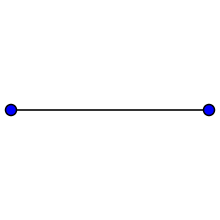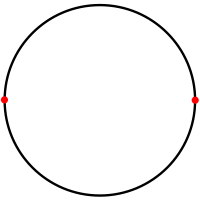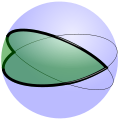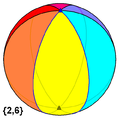- Digon
-
Digon 
A degenerate digon with two coinciding edges sharing the same verticesEdges and vertices 2 Schläfli symbol {2} Coxeter–Dynkin diagrams 



Area depends on geometric surface Internal angle (degrees) depends on geometric surface  On a circle, a nondegenerate antipodal digon is a tessellation composed of two vertices and two 180 degree arcs.
On a circle, a nondegenerate antipodal digon is a tessellation composed of two vertices and two 180 degree arcs.
In geometry, a digon is a polygon with two sides (edges) and two vertices. It is degenerate in a Euclidean space, but may be non-degenerate in a spherical space.
A digon must be regular because its two edges are the same length. It has Schläfli symbol {2}.
Some authorities do not consider the digon to be a proper polygon because of its degeneracy in the Euclidean case, but most formulae on general polygons do work on the digon. For example, the angle sum of an n-gon, (n − 2)π, would become 0 when n = 2, which is correct for a Euclidean digon.
Contents
In spherical tilings
In Euclidean geometry a digon is always degenerate. However, in spherical geometry a nondegenerate digon (with a nonzero interior area) can exist if the vertices are antipodal. The internal angle of the spherical digon vertex can be any angle between 0 and 180 degrees. Such a spherical polygon can also be called a lune.
-
Six antipodal digon faces on a hexagonal hosohedron tiling on the sphere.
In polyhedra
A digon is considered a degenerate face of a polyhedron because it has no geometric area and edges are overlapping. But sometimes it can have a useful topological existence in transforming polyhedra.
Any polyhedron can be topologically modified by replacing an edge with a digon. Such an operation adds one edge and one face to the polyhedron, although the result is geometrically identical. This transformation has no effect on the Euler characteristic (χ=V-E+F).
A digon face can also be created by geometrically collapsing a quadrilateral face by moving pairs of vertices to coincide in space. This digon can then be replaced by a single edge. It loses one face, two vertices, and three edges, again leaving the Euler characteristic unchanged.
Classes of polyhedra can be derived as degenerate forms of a primary polyhedron, with faces sometimes being degenerated into coinciding vertices. For example, this class of 7 uniform polyhedron with octahedral symmetry exist as degenerate forms of the truncated cuboctahedron (4.6.8). This principle is used in the Wythoff construction.

4.4.4
3.8.8
3.4.3.4
4.6.6
3.3.3.3
3.4.4.4
4.6.8See also
- Dihedron - a degenerate polyhedron with 2 faces.
- Hosohedron - a degenerate polyhedron with 2 vertices.
- Demihypercube
References
- Weisstein, Eric W., "Digon" from MathWorld.
- A.B. Ivanov (2001), "Digon", in Hazewinkel, Michiel, Encyclopaedia of Mathematics, Springer, ISBN 978-1556080104, http://eom.springer.de/D/d032390.htm
External links
Regular polygons Listed by number of sides1–10 sides 11–20 sides Others Star polygons Categories:- Polygons
Wikimedia Foundation. 2010.


